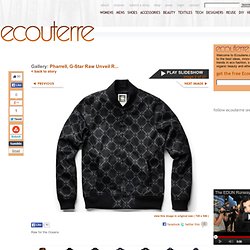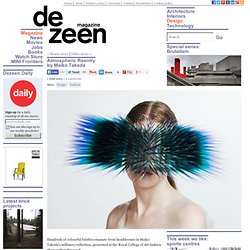

Raw for the Oceans « Ecouterre. Bionic Yarn estimates that the full collection employs an estimated 10 tons of recycled marine debris.

The line, which includes T-shirts, hoodies, boilersuits, trench coats, bomber jackets, jeans, and baseball caps in dark blue and black, features subtle detailing, plus original motifs based on its “Otto the Octopus” logo. RELATED | Pharrell, G-Star Raw Create Denim Made From Recycled Ocean Plastic Raw for the Oceans will be available for men and women in September, but it’s already making an impression. The Cannes Lions jury awarded the line with the Grand Prix for its inaugural product-design category. “The end result was the clothing itself,” U.S. judge Dan Formosa, a designer at Smart Design, told Ad Age.
. + Raw for the Oceans + G-Star Raw. Christopher Raeburn Soars at Spring/Summer 2014 London Fashion Week. Raeburn deployed an array of technical fabrics, including decommissioned parachute silk—preserved in its original candy-pink hue—originally used in humanitarian aid drops.

RELATED | Worn Again Turns Retired Virgin Hot-Air Balloons into Red-Hot Wearables Toying further with the aviation theme, Raeburn paired fabric from deconstructed Russian flight suits with silk organza, along with images of maps and weather patterns, to create sugar-spun shift dresses, hooded parkas, and shorts that were anything but fussy. “It was important to me that the Raeburn woman feels chic but comfortable wherever she goes,” he explained. + Christopher Raeburn.
Hana Mitsui Uses Japanese Weaving Techniques to Recreate Fabric From Waste. Japanese peasants employed sakiori from the mid-18th to 20th centuries at a time when resources were scarce and the cultivation of cotton difficult.

Like the practitioners before her, Mitsui shreds waste fabrics into thin strips, weaving them against a fresh warp to create an entirely new cloth. In contrast with the warm, durable workwear of her forebears, however, Mitsui’s creations are unmistakably high fashion. RELATED | Pure Waste Textiles: Why Fabric Waste Will Never Make Sense “I innovated the way to utilize the waste materials and created original yarns out of waste,” she says. “These yarns can be used for both industrial-weaving loom and hand-weaving loom. . + Hana Mitsui. Bay Area Eco-Designer Making a Difference. Sustainable Fashion: From Niche to Necessity. Atmospheric Reentry millinery fashion collection by Maiko Takeda. Hundreds of colourful bristles emanate from headdresses in Maiko Takeda's millinery collection, presented at the Royal College of Art fashion show earlier this week.

The adornments consist of transparent plastic spikes tinted with colour gradients at the bases and tips, which are held in place between sections of acrylic joined by small silver rings. "While hats are commonly made with substantial and durable materials such as fabric, felt, plastic, leather so on, instead I wanted to create ethereal experiences for the wearer through the pieces," Takeda told Dezeen. "Through the experiment process, I developed the technique to create a visual effect of intangible aura by layering printed clear film, sandwiched with acrylic discs and linked together with silver jump rings.
" One head piece comprises two domes covered in orange and red spines that sit either side of the face with in thin gap in between, and another mask with orange and purple spines wraps around the head like a sea cucumber.